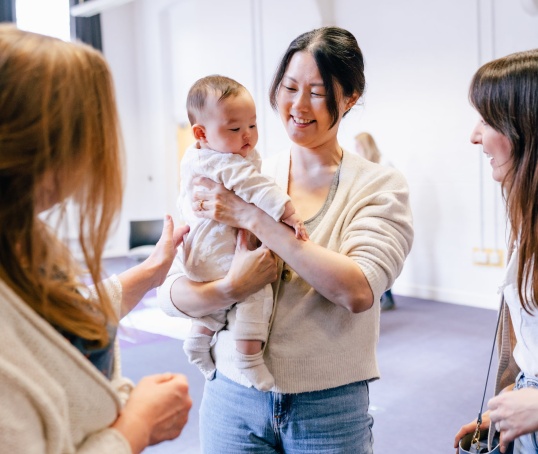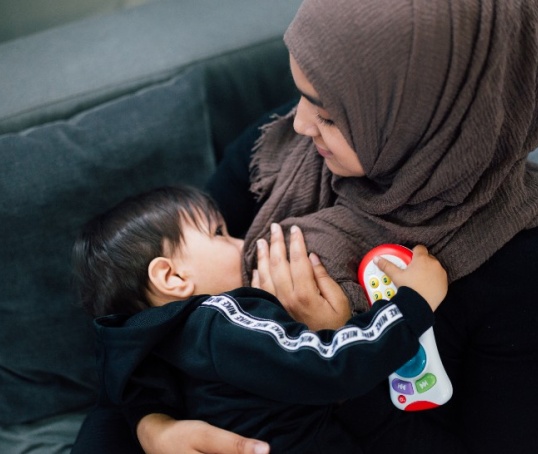Babies do cry a lot. It’s their last resort to get your attention. Here we try to decode crying to help you work out what they're telling you.
It can be incredibly frustrating and stressful for mums and dads, when all you want to do is satisfy their needs… If only you could work out WHAT that is.
As time goes on, you will get to know your baby’s language and things will get easier. There’s a certain amount of trial and error, as you try to work out what they’re telling you, but this responsive method is a good way to get to know them (Murray, 2014).
In the meantime, our guide can help you work out why your baby is crying in those early days and weeks.
What’s wrong, baby?
Is it hunger?
Chances are, if you have a young baby and they’re crying, they may well be hungry. Don’t be fooled by thinking ‘but they fed only an hour ago’. Babies don’t always stick to a schedule, and in the early days, they need lots of short feeds one after another to help them grow and for their brain to develop.
A hungry baby’s cry can begin with a rhythmical cry or whine. It quickly escalates, getting louder and louder (Shapiro, 2003).
Whether your baby is bottle fed, breast-fed or both, look out for these little signals, known as feeding cues. The following are signs to look for:
- turning their head – sometimes called ‘rooting’
- opening their mouth
- licking lips or sticking out their tongue
- trying to suck on anything in close contact to their mouth, often their fists
- getting increasingly agitated.
Keep an eye out for these, so you can respond quickly and feed your hungry baby before they get too upset.
Are they overtired?
Tired babies are not much different to tired grown-ups. They are grumpy and irritable.
If your baby is being a bit whiny and getting upset over seemingly small things, they might be overdue a sleep. Their cry might be long and hard, and they may not respond to you trying to calm them down (Shapiro, 2003).
The paradox of the tired baby is that the more tired they get, the harder it is for them to sleep. Try to crack the art of spotting when they’re just starting to feel tired. That way you should be able to get them settled to sleep before things get nasty.
Some common sleep cues to look out for are:
- rubbing their eyes
- yawning
- the ‘thousand mile stare’ – staring blankly into the distance.
Try soothing your overtired baby then putting them down in their cot to nod off (and give you a break). A quiet, dark room may also help to reduce stimulation and help baby to drift off to sleep. Failing that, the gentle rocking motion of being held in a sling or pushed along in a pram can help an overtired baby get some sleep. You could even try driving them somewhere to help them snooze.
Is it wind?
Most healthy, full-term babies don’t take air into their stomachs when feeding, but might when crying or agitated. If your baby needs to gulp milk because the flow is fast from a bottle or breast, they may gulp down air too. Paced bottle feeding or letting a breastfed baby control the flow will help prevent them swallowing air.
If your baby seems uncomfortable, giving them the chance to burp by gently massaging their back while they're upright may help. If your baby doesn’t burp within a minute or so, then they’re not going to.
If your baby is squirming around or arching their back, they might be telling you they need to fart as a result of gas in their intestines. A very gentle belly massage can help them release this gas.
Too much going on?
It’s easy to forget that babies can get overwhelmed. If they start to seem agitated and look away, they might be overstimulated.
This can be tricky if a friend has popped around to smile at your beautiful baby, but speak up. You know your baby best, so don’t feel bad for telling any well-meaning visitors that baby needs some quiet time.
Perhaps they’re uncomfortable?
Dirty nappy? Too hot? Too cold? There are so many reasons your baby might be less than pleased with their environment.
Check their nappy to see if they need a change. If they show any sign of nappy rash, use a suitable cream to help with any soreness.
If you’re concerned about temperature, feel the back of your baby’s neck to check they’re not getting too hot or cold.
Maybe it’s teeth?
Teething can lead to a very unhappy baby. While most babies get their first teeth around six months, it can happen much sooner.
Signs your baby is teething are:
- red cheeks
- teething rash on chin
- lots of drool
- constantly sucking and chewing on anything in reach
- some babies get sloppy poo, which can lead to painful nappy rash.
You might find giving your baby a teether toy can ease their pain. Read our teething articles for more hints and tips.
Are they in pain?
The cry of a baby in pain is often quite distinctive. It begins without warning and is long, loud and shrill, followed by a big pause, as if they’re holding their breath. They might tense their body, drawing up their hands and feet (Shapiro, 2003).
Give your baby a cuddle to calm them down and check all over their body to see if anything has caused them pain.
Could they be feeling unwell?
If your baby is crying constantly and you can’t console or distract them, they might be ill. Or if their cry doesn’t sound like a normal cry – it is weak, or high pitched – they could be ill. Check their temperature and seek medical advice from your GP if they have a fever, or if they are showing other symptoms of illness.
Maybe it’s you?
Babies are really good at picking up on our emotions, so if you’re feeling frazzled then they could be reacting to that. You could try putting them down somewhere safe for five minutes while you go and make a cuppa or phone a friend.
When you return you might find they’ve calmed down and nodded off. If they’re still crying, you need to pick them up and start again, but at least you’ve had a short break.
Maybe it’s… nothing?
If you’ve gone through all this and can’t find anything wrong, it might be that, well, it’s nothing. Frustrating as that may be.
It might be that your baby is going through the period of PURPLE crying – a perfectly normal stage of development where they can cry for hours yet they’re healthy. PURPLE is short for: Peak of crying; Unexpected; Resists soothing; Pain-like face; Long lasting; and Evening (NCSBS, no date).
Here’s one approach to this kind of crying:
‘...there will be times when you will not know what the crying is about. This doesn’t matter. What matters is that you calm them down and that you have the mental and emotional space in your minds to really hear and take seriously her panic and her pain.’ (Sunderland, 2007)
Cuddle time: Perhaps they just want a cuddle. Babies love to be held. This is especially the case during the first three months after birth, sometimes referred to as the fourth trimester. This is when babies are still adjusting to life outside the womb and crave close comfort from their caregivers (Brink, 2013).
Playtime: Maybe they’re bored, so try a change of scenery. Sing them a song, play a little or go outside. Perhaps just a bit of a bouncing up and down might do the trick.
Colic: Colic is another term for PURPLE crying. Read more about colic here.
Seek advice: Talk to your health visitor or GP to ensure there aren’t any underlying issues that could be causing your baby to cry a lot. Issues might include reflux, or tummy problems caused by allergies.
My baby won’t stop crying and I don’t know what to do
It can be extremely hard to deal with a crying baby who won’t be soothed when it appears nothing is wrong. But there are steps you can take to keep calm, see our article about how to cope and keep calm with a crying baby.
This page was last reviewed in March 2022.
Further information
Our support line offers practical and emotional support with feeding your baby and general enquiries for parents, members and volunteers: 0333 252 5051.
You might find attending one of our NCT New Baby groups helpful as they give you the opportunity to explore different approaches to important parenting issues with a qualified group leader and other new parents in your area.
Make friends with other parents-to-be and new parents in your local area for support and friendship by seeing what NCT activities are happening nearby.
Understanding Childhood also have a range of resources available online and to download, developed by child psychotherapists, including a leaflet on crying.
There’s also useful information on the NHS website.
The NSPCC website provides information and advice to parents and families.
The Lullaby Trust has lots of useful information and support for parents about safe sleep.
The AIMH website has some lovely videos for parents getting to know their babies.
Brink S. (2013) The Fourth Trimester; Understanding, Protecting and Nurturing an Infant Through the First Three Months. University of California Press, Berkeley.
Murray L. (2014) The Psychology of Babies. Constable and Robinson, London.
NCSBS. (no date) What is the period of PURPLE crying?
Shapiro L. (2003) The Secret Language of Children. Sourcebooks, Chicago: p20-21.
Sunderland M. (2007) What Every Parent Needs to Know. Dorling Kindersley Ltd, London: p37.




